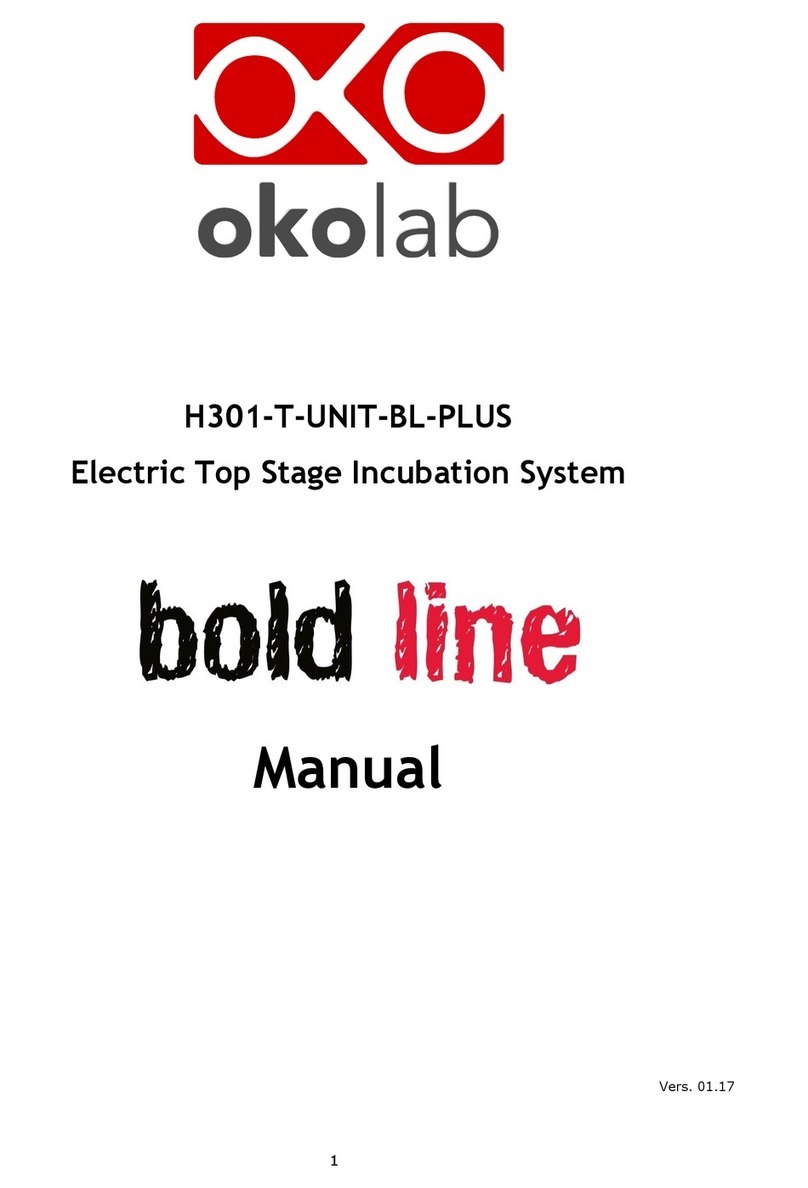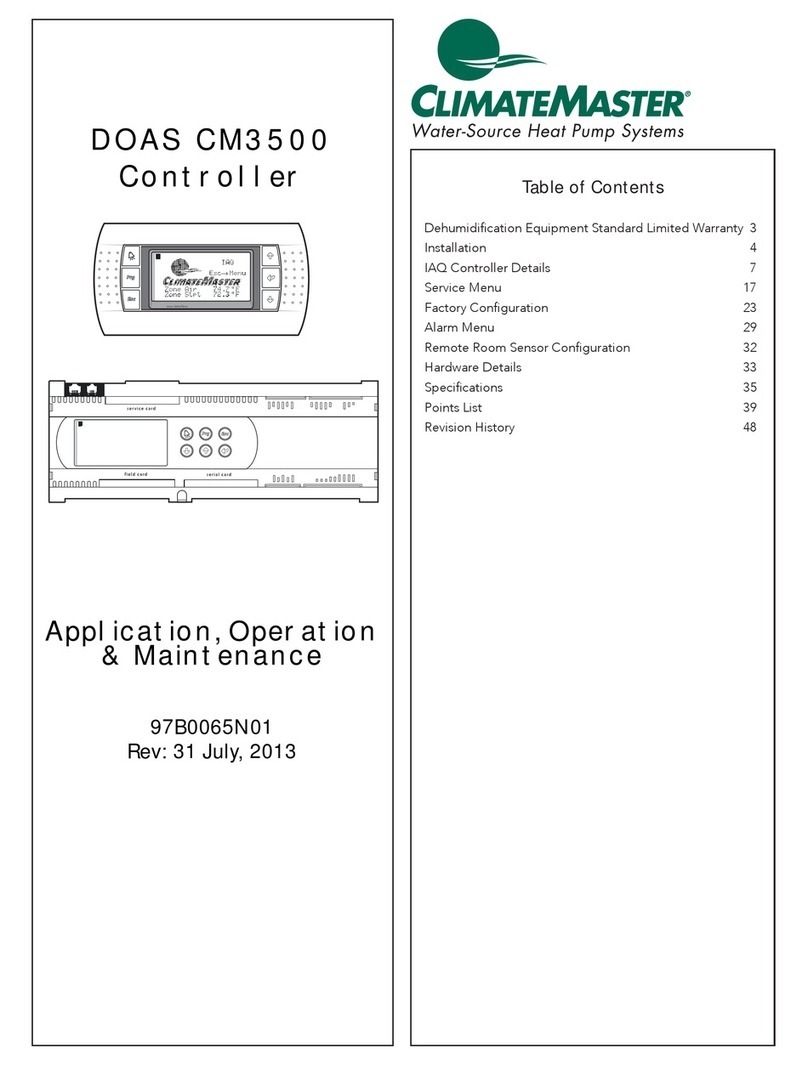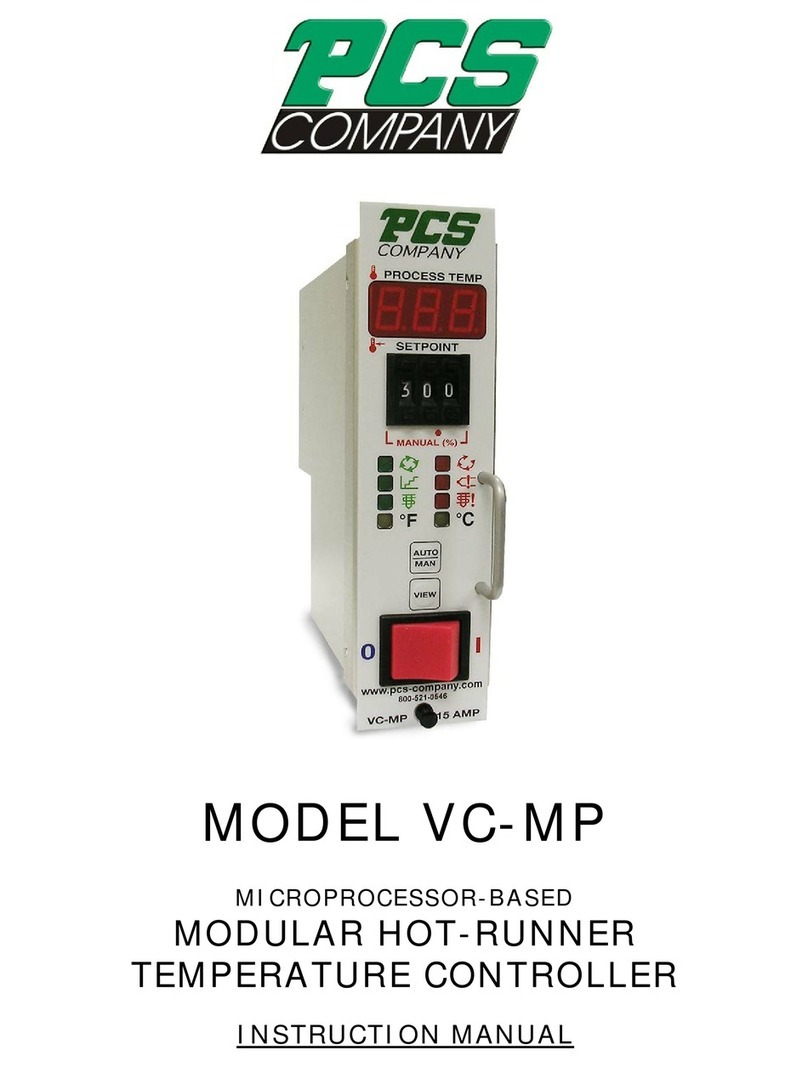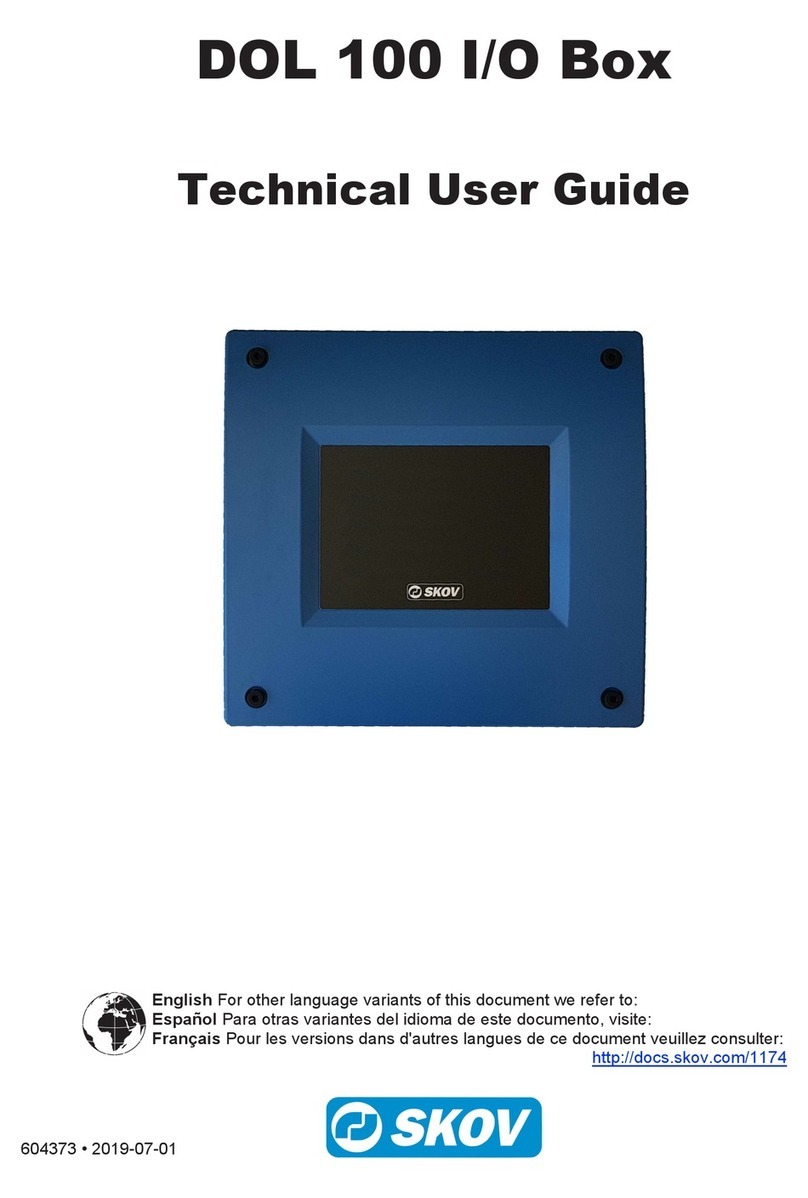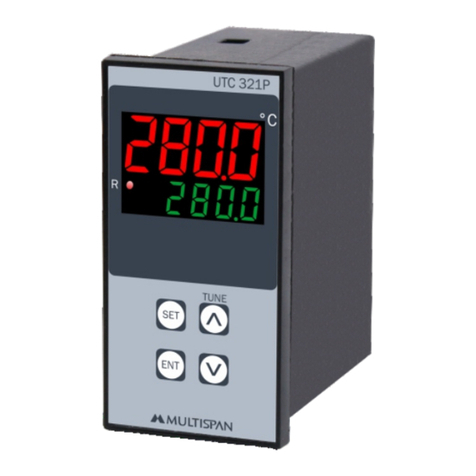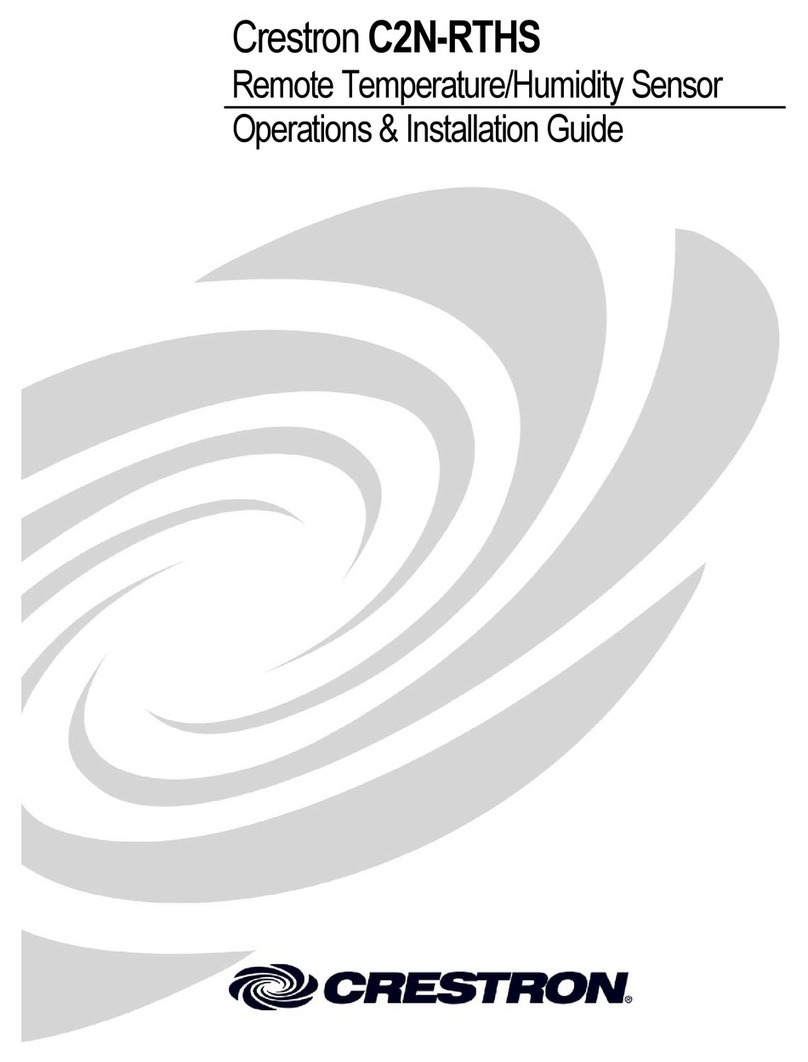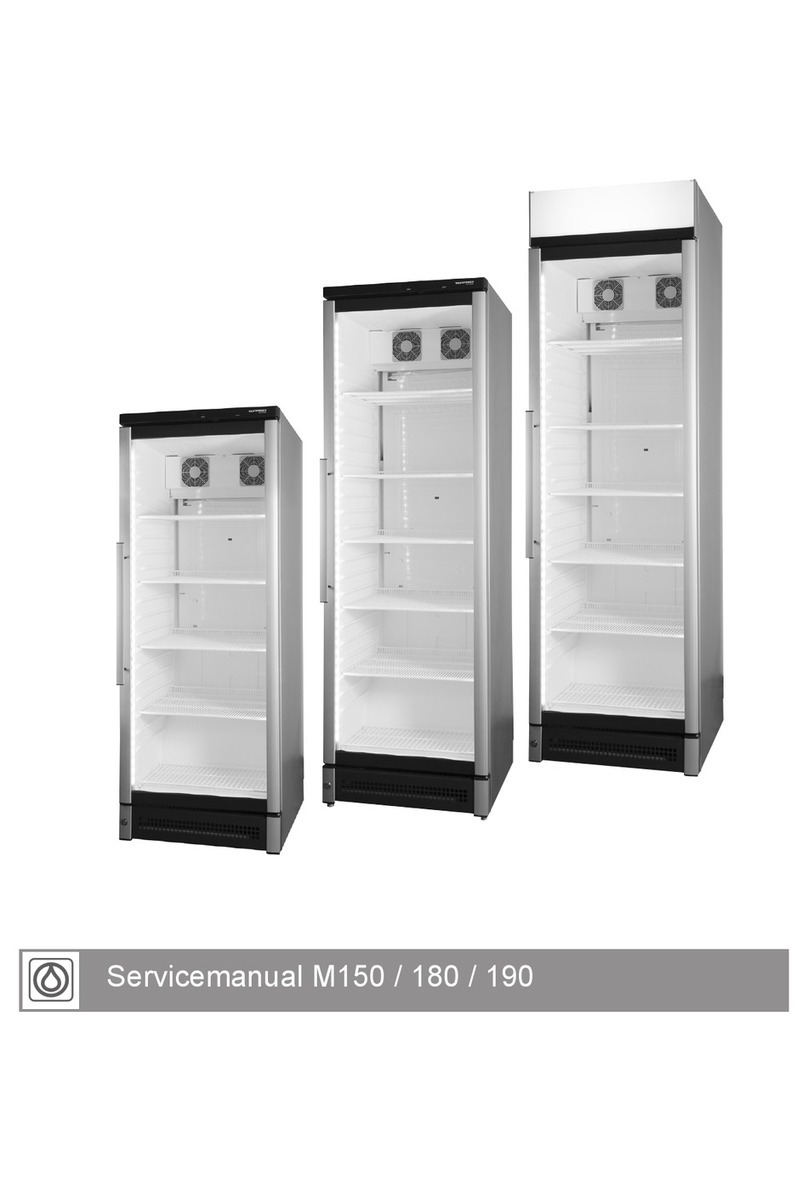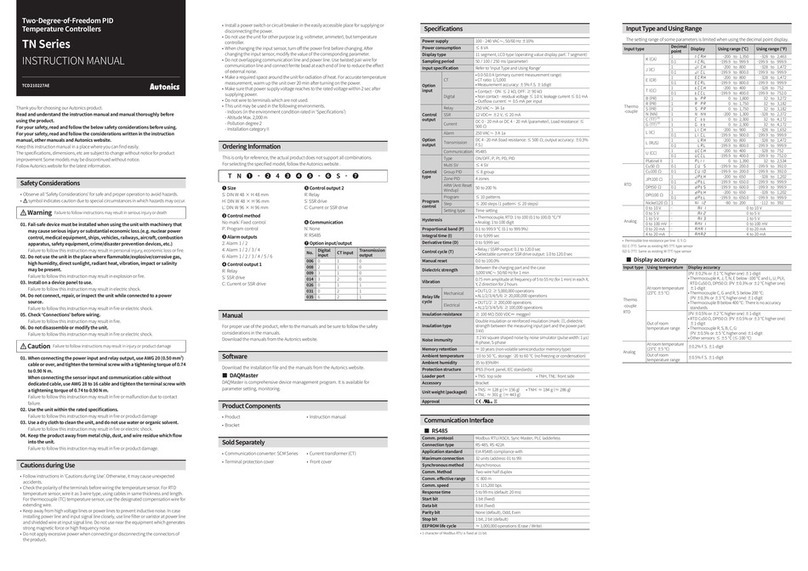Grant OPTIMA RANGE GD100 User manual

IN THE LABORATORY
SERVICE MANUAL
for the OPTIMA RANGE
GENERAL PURPOSE TEMPERATURE
CONTROLLER GD100 & GD120
Part No. 17592/Issue 1 July 2002

GD100/GD120
Contents
1 Introduction
1.1 General 4
1.2 Advice on Servicing 4
1.3 Cautions and Warnings 4
1.4 Electrical Safety 4
1.5 Connection to AC power supply
2 Specification Summary
3 Brief Mechanical Description
4 Description of Operation
4.1 AC Power Distribution and
Component Interconnections 7
4.2 DC Power Supplies 7
4.3 Temperature Measurement and Control. 7
4.4 Temperature Measurement
4.5 Temperature Control. 8
5 Fault Finding
5.1 Test equipment and tools required: 9
5.2 Initial Tests. 9
5.3 Fault Diagnosis. 9
6 Removal and Access
6.1 Tools Required 12
6.2 Removal of Cover 12
6.3 Removal of front panel assembly 12
6.4 Removal of Display PCB. . 12
6.5 Removal of PSU PCB. . 12
6.6 Removal of Heater. 12
6.7 Removal of Probe. 12
6.8 Removal of Float Switch.
6.9 Removal of Float and Float Shaft. 13
6.10 Removal of GD120 Motor. 13
6.11 Removal of GD100 Motor 13
6.12 Replacement of Over temperature
Cut-out GD120 only.
7 Setting Up and Testing 14
7.1 Test Equipment required 14
7.2 Functional Tests 14
7.3 Setting up DAC output 14
7.4 Heater Control
7.5 Calibration 15
7.6 Store Calibration Figures 15
7.7 Accuracy Check 15
4
5
6
7
7
8
9
12
See Fig 7
See Fig 8
See Figs 9 & 10
See Figs 11 & 12
See Fig 13
See Fig 14
See Fig 15 13
See Fig 16
See Figs 17 & 18
See Figs 18 & 19
See Fig 20 14
15
Part No. 17592/Issue 1 July 2002
Page 2

1 Introduction
1.1 General
Temperature Controllers GD100 and
GD120 are designed to be used with Grant P
series baths (plastic) for applications up to
99°C or Grant S series baths (stainless steel)
for applications to 120°C. They can also be
fitted to users own tank with a Grant
Instruments K clamp.
The GD100 and GD120 are identical except
that the GD120 has the following extra
features:-
DA temperature range up to 120°C
DA pump.
DAn over-temperature cut out.
DA more powerful motor.
DSoftware with the ability to set a
countdown timer.
DTemperature range can be restricted
by programming in the liquid used
DA high level alarm can be set.
1.2 Advice on Servicing
Adjustment, maintenance and repair
of the unit described in this service manual
should only be carried out by qualified people
who are aware of the workshop practices
appropriate to the grade of servicing. In
particular, unit covers should only be
removed by people who have been trained to
avoid the risk of electric shocks.
In the U.K. units may be returned to Grant
Instruments Service Dept. at the following
address:-
29, Station Road,
Shepreth,
Cambridgeshire.
SG8 6GB
Customers outside the U.K. should contact
the agent for their country for help with
repairs.
After unpacking, retain packing case and
packing for transportation.
1.3 Cautions and Warnings
The safety statements in this service manual
comply with the requirements of the HEALTH
AND SAFETY AT WORK ACT 1974.
In particular, Caution and Warning
statements are given in the form shown:
CAUTION: Use to indicate a correct method
or procedure to be followed to avoid damage
to equipment and other property.
WARNINGS: Attention to the use of
materials, processes, methods, tools,
procedures or limits which must be followed
exactly to avoid personal injury.
1.4 Electrical Safety
This unit meets the requirements of
IEC61010 parts 1 and 2.
Some test and setting up procedures require
covers to be removed.
Take note of warnings given to prevent
electrical shock by contact with live
terminals.
Before any connection is made to an a.c.
power supply, ensure that the power outlet to
be used is provided with an effective earth
(ground) connection.
If the use of an extension cable cannot be
avoided, earth (ground) protection must not
be negated by the use of an extension cable
not having an earth (ground) conductor.
It is recommended that the a.c. power supply
is fitted with a residual current circuit breaker
WARNING: Any interruption of the earth
(ground) conductor or earth (ground)
connections within or outside the unit may
render the unit dangerous to use.
.
GD100/GD120
Part No. 17592/Issue 1 July 2002
Page 4

1.5 Connection to AC power supply
These units are available for operation
either at 220-240V or 110-120V.
It is not possible to change the voltage
setting.
Check that the voltage printed on the serial
number plate, located at the rear of the unit,
is correct for the local a.c. power supply
voltage.
220-240V Version
This version of the unit has an IEC
mains input socket fitted in the rear panel
and is supplied with a separate a.c. power
supply cable, which is fitted with an IEC
connector and plug suitable for the country
for which it is supplied.
There are two supply voltage fuses located in
the drawer below the mains input socket and
may be removed using a small screwdriver to
gain access to the fuses.
The correct fuses are 1.25inch x 0.25inch
ceramic rated at 10 amps.
110-115V Version
This version of the unit has its power
supply cable permanently fixed to the rear of
the unit. The fuses are located in two panel
mounted fuse holders, turning the cap with a
screwdriver gives access to the fuses.
The correct fuses are 1.25inch x 0.25inch
ceramic rated at 20 amps.
It is recommended that the unit is tested with
the cable supplied by Grant Instruments.
However, if this is not possible, ensure that
the cable used has the correct current rating
and that its earth (ground) conductor is
continuous.
GD100/GD120
Part No. 17592/Issue 1 July 2002
Page 5

GD100
0 - 100°C
ambient + 5 - 99°C
LED
1.5Kw
1.4Kw
No
2.2Kg
3.6Kg
115/145/315 w/d/h
Yes
No
Yes
2 X 10 amp
2 X 20 amp
Temperature Range (using S tank)
Temperature Range (using P tank)
Temperature Display
Power 230V
Power 115V
Pump
Weight (unpacked)
Weight (packed)
Overall Dimensions (excl clamp)
Liquid level float switch
Over temperature cut out
Self-resetting thermal cut out in motor
Fuses ceramic 240V version
115V version
GD120
0 - 120°C
ambient + 5 - 99°C
LED
1.5Kw
1.4Kw
Yes
2.9Kg
4.3Kg
115/145/315 w/d/h
Yes
Yes
Yes
2 X 10 amp
2 X 20 amp
2 Specification
For use in the following laboratory conditions:-
Power supply:
Voltage options: 220-240V a.c. 50/60Hz
110-120V a.c. 50/60Hz
Room temperature: 10 C to 35 C
Humidity: Up to 75% rH
GD100/GD120
Part No. 17592/Issue 1 July 2002
Page 6

3 Brief Mechanical Description
The control units are housed in an
upright unit having a metal cover with a
plastic front panel. The control unit can be
mounted on a bridge plate on Grant tanks or
fitted to users own tank by using a Grant
Instruments K clamp.
The GD120 is fitted with a circulating pump
which can only be used in a closed loop
circulation system, for example a jacketed
vessel. It will not circulate liquid through an
open tank. A plastic moulding is provided to
connect output and input pipes for this pump.
When repairing the GD120 ensure that either
a blanking plate is fitted or the pump input
and output is shorted with a piece of pipe.
Mounted below a stainless steel chassis are
the submersible items, stainless steel heater;
temperature sensing probe; stirrer shaft fitted
with propeller; stainless steel float; pump and
stainless steel over temperature cut out. (last
two items GD120 only).
The plastic front panel is mounted on the
base and the display PCB is clipped on to it.
The power supply board is also clipped to the
front panel and its heat sink forms the upper
half of the rear panel.
Mounted on the rear panel is the IEC power
supply socket with the fuses in a drawer
which clips into the socket (240Vunits) or the
cable input (115V) with fuses mounted on the
lower half of the rear panel.
The steel cover is held with screws to the
chassis and the rear panel.
The push button mains switch is operated
through the elastomer front panel which also
has the operating buttons.
4 Description of Operation
4.1 AC Power Distribution and
Component Interconnections
There are two printed circuits in the
unit, the which contains the
power supplies for both boards and the
components for driving the heater triac IC3.
The other board is the
which is screwed to the front panel and
contains the processor and display and is
where the temperature control function takes
place.
The circuit diagrams for these boards are
and respectively.
The component layout diagrams for these
two boards are and .respectively.
The main connections to the unit and also
the low voltage connections between the two
printed circuit boards and the probe are
shown on the wiring diagrams and
.
4.2 DC Power Supplies
Refer to the power supply circuit
diagram . The DC power supplies are
obtained from mains voltage through
transformer mounted on the power supply
PCB. This transformer has two secondary
windings, one drives a full wave rectifier DB1
which produces a positive power supply
across C5 feeding a +5V stabiliser IC4, the
second produces a dc voltage across C7 via
diode D3, giving unstabilised +12V at pin 3.
The low voltage side of the transformer is
connected to the Display PCB through PL7.
4.3 Temperature Measurement and
Control.
The temperature control function is
shared between the DISPLAY PCB and the
POWER SUPPLY PCB
The temperature measurement function is
carried out on the display board and the
temperature control function on the power
supply board.
POWER BOARD
DISPLAY BOARD
Fig
1 Fig 2
Fig 3 Fig 4
Fig 5 Fig
6
Fig 1
T1
GD100/GD120
Part No. 17592/Issue 1 July 2002
Page 7

4.4 Temperature Measurement
With reference to the DISPLAY
CIRCUIT DIAGRAM the temperature
measurement probe is connected via PL5, to
pins 6 & 7 of IC3. IC3 is an A/D converter
whose digital output is fed to the processor
IC9. Diode D1 with R4 C9 & C10 provides
the reference voltage for the A/D converter.
The required temperature is set by feeding
pulses from an encoder mounted on the pcb
and controlled from the control knob on the
front of the unit, to pins 12 and 16 of the
processor IC9.
The A/D output measurement of temperature
is compared with the set temperature in the
processor IC9, this produces an error signal
which is converted to an analogue signal in
D/A converter IC8.
The analogue signal from IC8 is amplified by
IC1 and fed to the opto-isolator on the
POWER SUPPLY PCB via PL7 pins 4 & 5.
The processor displays the liquid
temperature on four LED displays via LED
driver IC7.
The processor clock is provided by crystal
XT1 and runs at 8 MHz. IC6 is a divider
which supplies clock pulses to IC3 at 2Mhz.
SW1 and SW2 are carbon track switches,
they enable the user to interface with the
processor via the 'F' (function) and 'S' (set)
buttons on the front panel.
IC10 is a programmable memory which
stores the parameters calculated for the unit
calibration.
4.5 Temperature Control.
With reference to the POWER SUPPLY
CIRCUIT DIAGRAM it can be seen that the
analogue signal from IC1 on the display
board is fed to opto isolator IC1 through PL 7
and then to pin 4 of IC2 via potential divider
R7 and R2. Trigger pulses to drive the triac
are generated when a comparator in IC2
detects that the voltage at pin 4 is greater
than the proportional control voltage at pin 3.
This proportional control voltage is provided
by the output of a low frequency ramp
generator ( 0.5V to 1.75V d.c.) which
appears at pin 1 and is fed to pin 3 through
R5.
Fig 2
Fig 1
The triac gating circuit delivers current pulses
to the triac gate at zero voltage crossing of
the a.c. supply.
This minimises interference caused by the
switching of the triac. The zero voltage
crossing points are sensed at pin 8 of IC2 via
R3.
When the set temperature is higher than the
probe temperature, an output at the zero
mains crossing points from IC2 pin 6
switches on the triac IC3 turning the heater
on. When the set temperature is lower than
the probe temperature the heater is switched
off
GD100/GD120
Part No. 17592/Issue 1 July 2002
Page 8

5 Fault Finding
WARNING: These instructions are
for use only by suitably qualified personnel.
To reduce the risk of electric shock while
working on the equipment when switched on,
refer to the wiring and circuit diagrams, which
shows where ac power is present. In
particular, keep tools and fingers clear of
connections at the triac, ac transformer, and
power input connector. The wearing of dry
rubber gloves is recommended.
CAUTION: Before undertaking work
on the unit, check that the correct fuses
are fitted .
Check that the available AC power supply is
correct for the unit, (see serial number plate).
5.1 Test equipment and tools required:
Digital Multimeter
Ranges: 250V AC
10A AC
20V DC
Digital thermometer
Range: 0 to 100 C (0.1 C resolution)
5.2 Initial Tests.
Fit the unit in its normal operating
position on a test tank.
Pour in sufficient cold water to cover the
heater.
Plug unit into the a.c. power supply and
switch on. Check that the displays comes on.
If it does not check the a.c. power supply
voltage and the fuses, two in the unit and
one in the plug.
Switch unit on and set temperature below
water temperature check that the alarm neon
is not lit.
If alarm neon is lit then check that there is
enough water in the test tank to lift the float
to operate the float micro switch. If the unit is
a GD120 and the alarm neon is still on check
that the over temperature cut-out is turned
fully clockwise and reset button is pressed.
Check that the stirrer is working. If stirrer is
not running check that the motor shaft turns
freely. If it is jammed the motor internal cut-
out may have tripped.
(FS1
and FS2) (see section 1.4)
Free stirrer motor and allow time for the re-
settable internal trip to reset. If the motor is
still not running it probably has an open
circuit winding.
Disconnect motor and check continuity, if it is
open circuit the motor will have to be
replaced .
Set unit temperature above the water
temperature. Check that the heater neon
comes on and the bath
temperature increases and stabilizes at the
set temperature.
If the temperature either does not increase or
continues to rise above the set temperature
there is a fault with the temperature control
and the following procedure should be
carried out.
5.3 Fault Diagnosis.
Whilst it is not possible to cover all fault
conditions, the procedures given on the
following page provide guidance.
Plug the unit into an AC power supply and
switch on.
(see 6.10 or 6.11)
GD100/GD120
Part No. 17592/Issue 1 July 2002
Page 9

IF THE DISPLAY
DOES NOT COME ON?
Check d.c. power supplies on power pcb
They should read as follows:-
Plug 7 Pin 3 - 12V
Plug 7 Pin 1 or 6 - 5V
Both these voltages are referred to 0V on pin 2 or 7 of Plug 7.
If they are not correct check power supply components particularly
transformer T1. If display is still off check lead connection to
display pcb or change power supply board.
Over-temperature neon
constantly on.
(A float switch to ensure there
is sufficient liquid in the tank to
cover the heater, is fitted to
both GD100 and GD120. An
over temperature cut-out,
which can be adjusted from
the front panel and is designed
to protect users samples, is
fitted to the GD120 only.)
Check that float (stainless steel bulb situated adjacent to heater) rises
up with water level. If it does not check that shaft slides up and down
freely and operates the micro switch. Check that the float has not
sprung a leak and filled with water. Disconnect unit from mains supply
and remove leads from float micro-switch. With multi-meter set to
resistance range check that micro-switch switches on and off as lever is
operated.
Check the over-temperature cut-out by disconnecting the unit from
mains supply and removing leads from cut-out terminals. With multi-
meter set to resistance range check the resistance between the
terminals is a short circuit when cut-out is turned fully clockwise and the
reset button is pressed. Turn cut-out fully anti-clockwise and check that
resistance between terminals is open circuit.
IF TEMPERATURE
DISPLAY SHOWS
open
Probe is open circuit, or unplugged from PCB.
Replace probe or reconnect plug.
IF TEMPERATURE
DISPLAY SHOWS
shrt
Probe is short circuit. Check probe resistance.
See table on page 18. Replace if necessary.
GD100/GD120
Part No. 17592/Issue 1 July 2002
Page 10

STIRRER MOTOR
NOT WORKING.
Check that the motor shaft turns freely. If it is jammed the motor
internal cut-out may have tripped. Switch unit off and free motor. Allow
time for the motor to cool. This will reset internal cut-out. If this is not
the fault the motor winding is probably open circuit. Disconnect motor
and check continuity of winding. If the winding is open circuit the motor
will have to be changed, see 6.9.
THE DISPLAY DOES
NOT CHANGE TO SET
TEMPERATURE AND
FLASHES WHEN S
BUTTON IS PRESSED.
Ensure button is making good contact with track on pcb.
Replace IC9 microprocessor.
SET TEMPERATURE
WILL NOT CHANGE
WHEN TURNING SET
TEMP. KNOB.
Replace encoder on pcb.
Replace IC9 microprocessor.
HEATER WILL NOT
TURN OFF WHEN
LIQUID
TEMPERATURE IS
REACHED.
Check triac by unsoldering one end of R6 on Power pcb. Triac
should turn off. If it stays on it must be replaced.
Replace IC1 & IC2 on Power Supply Board
HEATER WILL NOT
TURN ON WHEN SET
TEMPERATURE IS
ABOVE LIQUID
TEMPERATURE.
Check heater resistance
Check probe resistance.
Triac, IC1, IC2 (all on Power pcb) may need changing. .
GD100/GD120
Part No. 17592/Issue 1 July 2002
Page 11

6 Removal and Access
WARNING: Before carrying out the
following procedures switch off the unit and
disconnect it from the power supply. For
some procedures it may be necessary to
remove the safety protective earth
connection from the ac power input socket
and/or internal earth connections. You must
ensure that these connections are remade
tightly on completion of reassembly.
6.1 Tools Required
62 nonslip cross point screwdrivers
(small & medium blade)
61 flat or socket spanner 14mm A/F
61 socket wrench 2mm
6Heat conducting paste (for triac and
temperature probe)
6Pencil bit soldering iron
6.2 Removal of Cover
Remove four fixing screws 'B' using
the 2.0mm socket wrench. Loosen two
screws 'A' in rear of unit. Carefully slide
cover off, checking that the earth wire is not
caught.
When clear of unit unplug earth wire.
Replace cover in reverse order. When
replacing ensure that the tongue on the
cover correctly fits into the recess in the
middle of the front moulding and the slots go
over the rear screws.
Ensure that the cover earth wire is
reconnected.
6.3 Removal of front panel assembly
Remove the two screws marked 'C' in
chassis under the panel. Remove leads from
mains switch. Disconnect plugs 5&7 from
display pcb. Remove neons from holes in
front panel. Note: the neon with the yellow
sleeve goes into the lower hole for refitting.
Unscrew over-temperature cut-out from
panel and remove carefully, noting positions
of button, spring and stop plate (see FIG 20).
With a small screwdriver gently lift clips
holding printed circuit board. Panel is now
free to be removed.
See Fig 7
See Fig 8
6.4 Removal of Display PCB.
Remove front panel above.
Remove processor IC9 to gain
access to pcb clip.
Unscrew over temperature cut out and
remove carefully noting position of button,
spring and stop plate. for re-
assembly. (GD 120 only).
Squeeze together the two clips 'D'
and lift off PCB.
6.5 Removal of PSU PCB.
Unplug all wires in turn from the PCB
recording position of each one.
Remove screw and nut 'F' holding triac to its
heat sink. Remove two screws 'E' holding
PCB to rear panel.
With a small screwdriver gently lift clips
holding the board to the front panel.
. The board may now be removed.
Note: When fitting new board apply a small
amount of heat conducting paste to the face
of the triac before screwing to the heat sink.
6.6 Removal of Heater.
Remove the leads from the heater
terminals. Unclip cut out bulb from heater
stem. Remove the two screws 'G' this will
release the heater. (In the case of GD100
these screws also hold one side of the
deflector plate).
6.7 Removal of Probe.
Remove the front panel .
Remove the psu pcb without unplugging the
leads .
This will allow the printed circuit board to be
moved aside far enough to allow the probe to
be withdrawn from the unit.
Remove the fixing screw 'N' and withdraw
probe from unit.
See Figs 9 & 10.
see 6.3
(see Fig 9)
See Fig 20
(see Fig
10)
See Figs 11 & 12.
(see Fig
12)
See Fig 13
See Fig 14
(see 6.3)
(see 6.5)
GD100/GD120
Part No. 17592/Issue 1 July 2002
Page 12

6.8 Removal of Float Switch.
The float switch is fixed by two screws
' P ' to a bracket adjacent to the heater
terminals. To gain access to these screws
the bracket must first be removed by un-
screwing the holding screw 'H' in the rear
panel and un-clipping the bracket from the
base of the unit. Once the bracket is free it is
possible to access the screws holding the
switch.
Remove switch, noting position of arm
relative to the bush on float shaft.
Remove wires from switch.
When fitting new switch ensure insulation
between switch and bracket is in place and
the switch arm engages correctly with bush
on float shaft.
6.9 Removal of Float and Float Shaft.
Loosen the grub screw 'J' holding the
bush on the float shaft. The float is screwed
to the float shaft and must be removed by
gripping the shaft with a pair of pliers and
unscrewing the float. It is held with lock tight
so may be a little difficult to turn. The shaft
may now be withdrawn from the bush and
removed from the unit.
Note: When replacing the float and shaft the
bush must be adjusted so that the micro
switch operates 3mm before the float
bottoms on the pump (GD120) or the
deflector bracket (GD100).
The best way to achieve this is to insert a
3mm spacer between the float and pump or
deflector bracket and adjust the bush on the
shaft to the point where the micro switch just
operates.
6.10 Removal of GD120 Motor.
The screws fixing the motor are
situated under the base plate and pump
moulding so these will first have to be
removed. To do this:-
Unclip cut out bulb from heater stem and
remove heater (see 6.6).
Unscrew float from float shaft (see 6.9).
See Fig 15
See Fig 16
See Figs 17 & 18
Unscrew stirring propeller from bottom of
pump shaft.
Remove pump housing which is secured with
four screws 'K'.
Remove the pump impellor which is held by
a grub screw 'L'.
Remove all screws from the base plate which
may now be removed by pushing sideways
to release the clips at the rear edge.
Slide the moulding and base plate down the
motor shaft far enough to gain access to the
motor screws 'M' which can now be released.
Unplug the power leads to the motor.
Clear the psu pcb far enough aside
to enable the motor to be withdrawn from the
unit.
Note: When replacing the pump impellor it
must be positioned on the motor shaft so that
when the shaft is moved up and down due to
shaft float, the impellor does not rub on the
pump housing at either extreme of its float
6.11 Removal of GD100 Motor
The screws fixing the motor are
situated under the base plate so this will first
have to be removed. To do this:-
Unscrew stirring propeller and remove
deflector plate by removing the four screws
'N'.Two of these screws also hold the heater
which can now be removed after
disconnecting the leads. Unscrew the float
from its shaft, the shaft will have to be
gripped with a pair of pliers to do this.
Remove all screws from the base plate and
release the clips at the rear of the base plate
by pushing sideways. This will enable the
base plate to be removed giving access to
the motor fixing screws 'M' .
Gently unclip the printed circuit board from
the front panel with a small screwdriver and
remove the two fixing screws in the rear of
the board. The printed circuit board can now
be moved aside far enough to allow the
motor to be removed from the unit.
Unplug the motor leads, release screws 'M'
and remove motor from unit.
(see 6.5)
See Figs 18 & 19
(Fig 18)
GD100/GD120
Part No. 17592/Issue 1 July 2002
Page 13

6.12 Replacement of Over temperature
Cut-out GD120 only.
Remove front panel
Remove the two screws holding cut-out to
front panel. Retain knob, spring, sleeve and
stop plate and note the order these parts are
assembled.
Unclip bulb from heater stem and withdraw
capillary through base (grommet will have to
be removed).
When fitting new cut-out make sure location
spike on knob fits in hole in cut-out body. .
See Fig 20
(see 6.3.)
7 Setting Up and Testing
7.1 Test Equipment required
6Earth bonding tester
6Test tank
6Digital Thermometer
7.2 Functional Tests
a) Place unit on water bath and switch ON,
check that LED display comes on and unit
type d100 followed by version number of
software is displayed i.e. 1.02.
b) Ensure that the motor runs freely.
c) Use a screwdriver to push down the float,
check that the motor stops and the alarm
neon illuminates.
d) Release the float ensuring that it rises.
Check that motor starts and alarm neon goes
out.
e) GD120 only. Turn over temperature cut-
out screw anti-clockwise and ensure that
alarm neon illuminates. Turn screw fully
clockwise and press button, make sure alarm
neon goes out.
7.3 Setting up DAC output
If the display board has been changed
the DAC will have to be set. To do this carry
out the following procedure:-
a) If COLD is displayed press either button.
b) Press 'F' and 'S' simultaneously for 5
seconds. Green LED display should show
LCAL. (it may take several attempts to
achieve this).
c) Rotate knob until display shows dAC.
d) Press 'S' display shows 0.
e) Rotate knob to display password of 1763.
f) Press 'S' the display will change to 50
(50 is the default value, if unit has been
previously set up the set value will be
displayed).
GD100/GD120
Part No. 17592/Issue 1 July 2002
Page 14

g) Rotate knob to display a DAC value of
200. Adjust potentiometer VR1 on power
supply board to the point where the heater
neon just stops flashing and stays on
continuously. (On some early models the
power supply boards do not have a
potentiometer if this is the case go straight to
(h).
h) Rotate knob to set DAC to a value where
the heater neon just stops flashing and
remains off for at least 10 secs.
i) Rotate the knob to set the DAC value to 10
less than the value in (h) e.g. If value found
in (h) is 52 set DAC value to 42. Press 'S' to
enter value.
j) Press 'F' twice to return to main screen.
7.4 Heater Control
a) Press button 'S' the display should now
flash
b) Rotate the setting knob to give a SET
TEMPERATURE at least 5°C above ambient
or initial indicated bath temperature (but not
higher than 40°C).
c) Allow bath to stabilise for at least 5
minutes at the SET TEMPERATURE
d) BATH SET TEMP and BATH TEMP must
be identical viewed over a period of at least
10 seconds on the LED
7.5 Calibration
a) Place the unit in a tank of water who's
temperature is below 20°C. Set the SET
TEMPERATURE to a temperature which is
above the water temperature but not greater
than 20°C, allow the unit to stabilise for at
least 5 minutes.
b) Press 'F' and 'S' simultaneously for 5
seconds. The display should show LCAL. (It
may take several attempts to achieve this).
c) Press 'S'
d) Turn knob so that the average
temperature of the display over a period of
15secs, equals the temperature on the
external thermometer.
e) Press 'S' to accept
f) Press 'F'
g) Set temperature to 70°C
h) Allow the water temperature to reach 70
and stabilise for at least 5 minutes.
i) Press 'F' and 'S' simultaneously for 5
seconds. Display will read LCAL. (It may
take several attempts to achieve this).
j) Turn the knob to select on the LED display
hCAL then
k) Turn the knob so that the average
temperature of the display over a period of
15secs, equals the temperature on the
external thermometer.
l) Press 'S' to accept.
7.6 Store Calibration Figures
a) Press 'F' and 'S' simultaneously for 5
seconds. The display will show LCAL. It may
take several attempts to achieve this
b) Rotate the knob through hCAL, rst to
FCAL.
c) Press 'S', LED shows 0.
d) Rotate knob to display password of 1763
on green LED.
e) Press 'S' to return to main screen and
store the calibration figures.
7.7 Accuracy Check
a) Having completed 7.5 and 7.6 allow a
further 5 minutes to elapse, check that the
difference between the units indicated
temperature and the external thermometer is
not more than 0.1 C
Press 'S'
GD100/GD120
Part No. 17592/Issue 1 July 2002
Page 15

8 Electrical Safety Tests
With the unit disconnected from the
AC power supply, and the power supply lead
plugged into the unit, perform the following
safety tests before returning the unit to the
customer.
8.1 Earth Bonding Test
Use a low resistance measuring
instrument to check that the resistance
between unit chassis and power cable earth
connector is less than 0.1 ohm.
8.2 Insulation Resistance Test
Set power switch to ON, and check
that cut out is reset by pressing reset button.
Connect the live and neutral pins of the
power supply plug together. Use a 500V
insulation resistance tester and measure the
insulation resistance between the earth and
live/neutral pins. This should be greater than
10 Mohm.
9 Final Inspection
a) Check that wiring is not trapped or nipped.
b) Check that the over temperature cut-out
bulb has been fitted correctly to the heater.
c) Check that cut-out has been correctly
screwed to the front panel and reset button
operates smoothly.
d) When re-fitting the cover ensure that the
earth wire is connected. Gently shake unit to
ensure there are no loose items left within
the unit.
GD100/GD120
Part No. 17592/Issue 1 July 2002
Page 16

Fuse
Probe
Heater
Mains Switch
Micro switch
Motor (GD100)
Motor (GD120)
Power Socket
Fuse Drawer
Fuse Holder
Fuse Cap
Micro switch
Cord set, mains power 240V UK
Cord set, mains power240V Europlug
Cord set, mains power110V
Front Moulding
Keypad
Neon
Display PCB (GD100)
Display PCB (GD120)
Power PCB (GD100 & 120)
Triac
Transformer
I.C.LM358N
I.C.CD74HC4040
I.C.MAX550ACPA
I.C.AT89C55-24PC
I.C.M5450
I.C.AD7706BN
I.C.25LC080P
I.C.UAA 1016B
I.C.HCNW 135
I.C.LM 7805
TransistorZVP
Diode1N4006
Zener Diode3V3
Encoder
Pump Blanking Plate
'O' Ring for use with 16868
User Manual
10 List of Spare Parts
GD100 & GD120
220-240V
02407
04045
16542
16821
16833
16819
16548
09794
09795
16833
09810
13948
16612
16617
04038
GD100 DISP PCB
GD120 DISP PCB
GD100 PSU PCB
01542
16656
11324
12238
16673
16675
16677
16869
17054
03985
16652
09817
12263
16919
16919
16702
16868
04086
17090
GD100L & GD120L
110-120V
(02409)
(17104)
(16820)
(16549)
(04031)
(04032)
(13946)
PCB(GD100L PSU PCB)
(01280)
(17258)
GD100/GD120
Part No. 17592/Issue 1 July 2002
Page 17

11 Drawings
Fig 1
Fig 2
Fig 3
Fig 4
Fig 5
Fig 6
Fig 7 - 20
Circuit Diagram Power Supply
Circuit Diagram Display
Component Layout Power Supply Board
Component Layout Display Board
Wiring Diagram GD100 and GD120
Wiring Diagram GD100L and GD120L
Mechanical Diagrams
Temperature ºC Resistance W
0 1000.0
5 1019.5
10 1039.0
15 1058.5
20 1077.9
25 1097.3
30 1116.7
35 1136.1
40 1155.4
45 1174.7
50 1193.9
55 1213.2
60 1232.4
65 1251.6
70 1270.7
75 1289.8
80 1308.9
85 1328.0
90 1347.0
95 1366.0
100 1385.0
12 Probe Resistance Values
GD100/GD120
Part No. 17592/Issue 1 July 2002
Page 18

R8
10K
(4K7)
R1
390R
R12
T24
T25
T6
PL7/4
IC 3
C2
470µ
C1
100µ
D1
1N4006
D2
15V
C9
0µ1
+12V
VR1
10K
R13
1K
R7
470R
R2
10K
R3
180K
C8
1µ
C10
1µ
R4
100K
R6
100R
R5
220K
+
_
DB1
C4
2200pF
C3
2300pF
R10
270K
(180K)
D3
1N4006
T1
C7
220
16V
µC5
1000µ
C6
0µ1
+5V
IC 1
IC 2
IC 4
OPTO-ISOLATOR
28
55
821
3
6
7
2
1
3
4
6
3
6
7
8
10
9
1
4
5
2
PL7/5
PL7/3
PL7/1
PL7/6
PL7/2
PL7/7
PL5/1
FS 1
FS 1
FS 2
MAINS
SWITCH
IEC
MAINS
SOCKET
110V UNIT
230V UNIT
L
N
E
LIVE
(smooth wire)
FS 2
NEUTRAL
(ribbed wire)
HEATER HEATER
NEON
R9
270K
(180K) T21
T23
T19T20T18
T4
T3
T2
T7
T3
M
FLOAT
SWITCH
COVER
COVER
OVERTEMPERATURE
CUT OUT
(GD 120 ONLY)
ALARM
NEON
CHASSIS EARTH BRKT
DISPLAY PCB
12V UNREG
POWER SUPPLY PCB
from IC 1
PROBE
5V REGULATED
0V
PL5/2
Fig 1 Power Supply Circuit Diagram GD100/100L/120/120L
NOTE:
RESISTOR VALUES SHOWN;
230V version
(110V version)
GD100/GD120
Part No. 17592/Issue 1 July 2002
Page 19

IC9
AT89C55
IC7
LED DRIVER
IC3
AD7706
IC10
25LC080P
IC6
4040
IC8
D/A
IC1
LM358N
C16
0µ1
C35
10µF
C20
0µ1
C23
0µ1
C26
0µ1
C19
0µ1
C21
0µ1
C33
0µ1
C1
22pF
C2
22pF
13
SW1
(F)
SW2
(S)
12 5
C4
1000pF
R4
47R
RP2a
10K
RP2c
10K
RP2b
10K
RP2d
10K
R21
47R
REF IN
RST
DATA
IN
DATA
EN
CLK
RP4b
10K
RP4c
10K
RP4d
10K
R12
39K
RP4a
10K
0V
0V
0V
0V
0V
0V
+5V
+5V
+5V
+5V
+5V
+5V
XT1
C28
10µ
C10
0µ1
C25
0µ1
C9
10µ
C30
0µ1
PL5/1
PL5/2
PL1/1
PL1/2
PL1/3
D3
1N4006
D2
1N4006
D1
3V3
L2
4
4
11
21
5
22
1
6
2710
11
8
16 1
CLK
9
7
R5
2K2
TR1
ZVP2110AD
R1
2K2
6
4
3
2
1
18
15
19
12
16
34
35
26
21
21
3
SCK
S1
S0
7
6
2
5
1
4
ENCODER
22 23
23
20
1
22
19
8888
VR1
20K LED4
x100
+5V
LED3
x10
LED2
x1
LED1
x0.1
40
7
25
7
6
2
4
5
3
1
3
1
2
7
8
6
5
C36
10µ
0V
PL7/1
PL7/3
PL7/4
PL7/5
C11
0µ01
C15
0µ01
RP3f
10K
RP3e
10K
+5V
8
VCC
WP
CS
HOLD
0V
+5V
8
PL7/7
0V IN
IC1
OPTO
ISOLATOR
PL7/2
PL7/6
12V UNREG
IN
0V
6
0V
27
R3
10K
+5V
11
PROBE
I/P
10
8
20
9
0V
C32
0µ1
C29
10µ
C12
0µ1
0V IN
+5V REG IN
+5V REG IN
Fig. 2 Display Circuit Diagram GD100/100L/120/120L
0V
0V
+5V
IC10 is mounted
under IC9 on
the PCB
PL1 for
Test purposes
only
RP3h
10K
32
0V
A/D
PROCESSOR
C3
1000pF 4
GD100/GD120
Part No. 17592/Issue 1 July 2002
Page 20
This manual suits for next models
1
Table of contents
Popular Temperature Controllers manuals by other brands

Magnum
Magnum M9-RTHS1 quick start guide
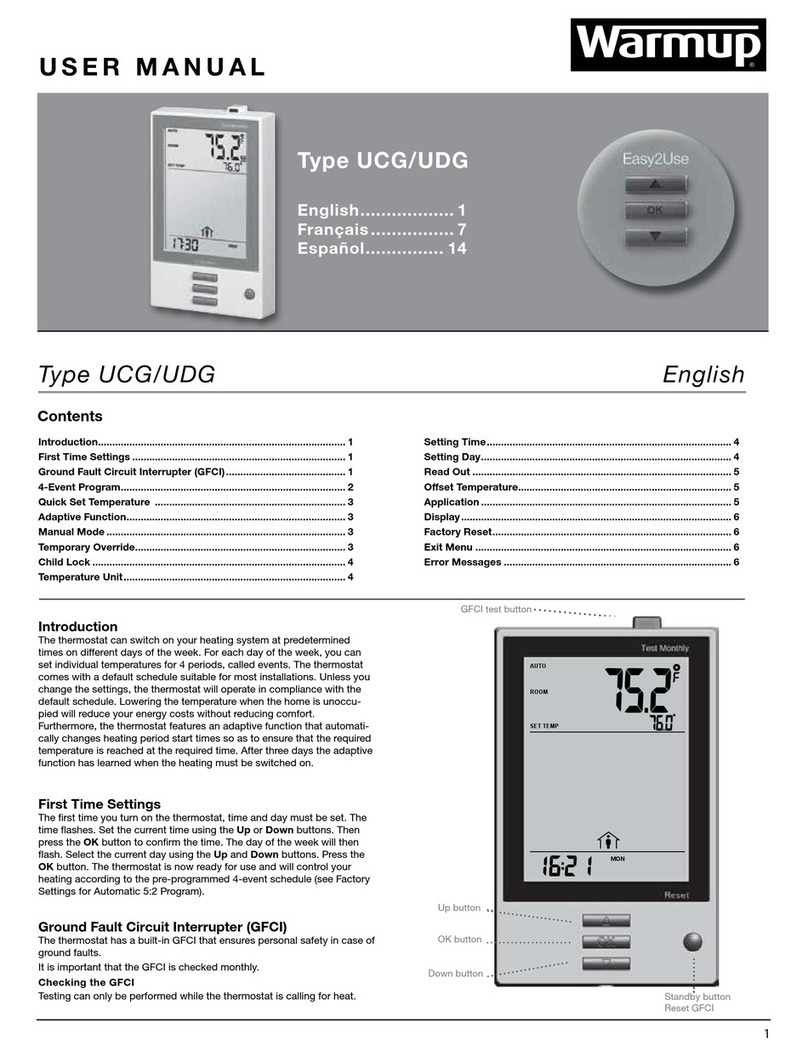
Warmup
Warmup UCG user manual
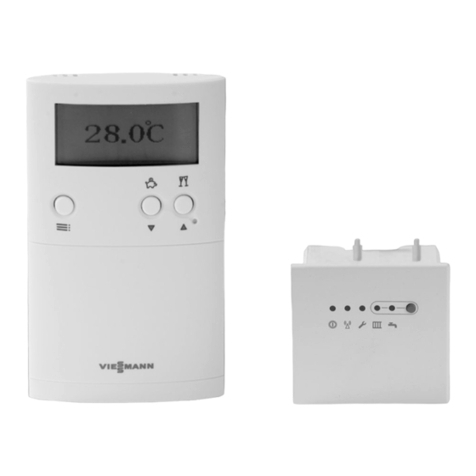
Viessmann
Viessmann Vitotrol 100 UTDB-RF2 Installation and service instructions

Middleby Marshall
Middleby Marshall 37626 Installation, programming and troubleshooting instructions

THORLABS
THORLABS MTD415T datasheet
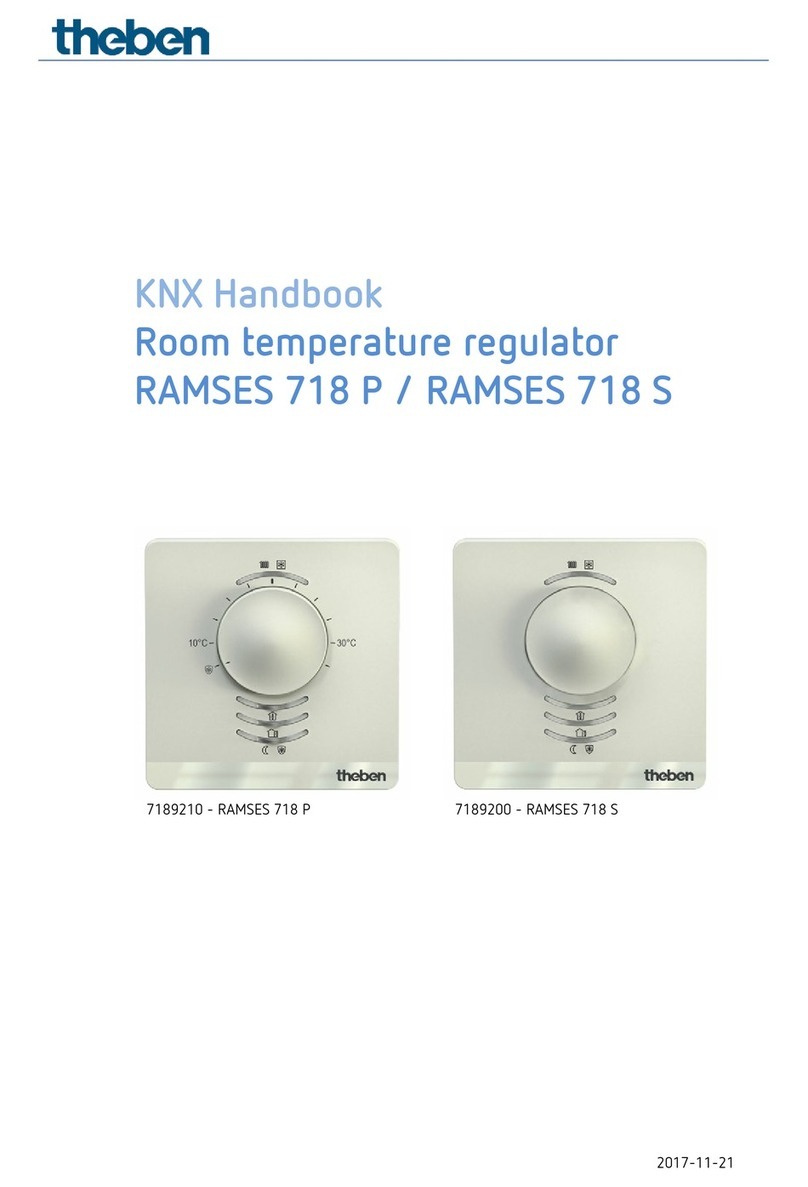
Theben
Theben KNX Series Handbook

